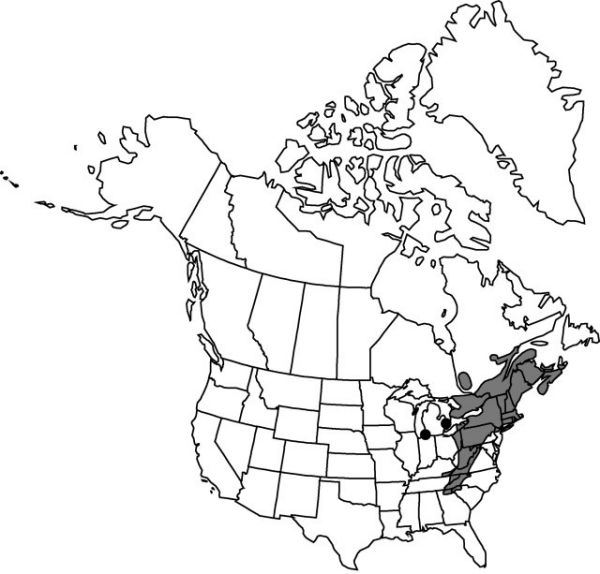Difference between revisions of "Trillium undulatum"
Ges. Naturf. Freunde Berlin Neue Schriften 3: 422. 1801.
imported>Volume Importer |
imported>Volume Importer |
||
| Line 56: | Line 56: | ||
|publication year=1801 | |publication year=1801 | ||
|special status=Endemic | |special status=Endemic | ||
| − | |source xml=https:// | + | |source xml=https://bitbucket.org/aafc-mbb/fna-data-curation/src/2e0870ddd59836b60bcf96646a41e87ea5a5943a/coarse_grained_fna_xml/V26/V26_116.xml |
|genus=Trillium | |genus=Trillium | ||
|subgenus=Trillium subg. Trillium | |subgenus=Trillium subg. Trillium | ||
Latest revision as of 21:11, 5 November 2020
Rhizomes horizontal, short, stout, ± praemorse. Scapes 1–3, dark greenish maroon, round in cross section, 1.1–4 dm, glabrous. Bracts strongly petiolate; blade dark green over maroon, main veins prominent, ovate to long-acuminate, 12–18 × 8–20 cm, ± glossy, base above petiole rounded, apex acuminate; petiole 4–17 mm. Flower opening above bracts, erect, odor unknown; sepals conspicuous, spreading, wine red to dull maroon green, rarely white-striated, lanceolate-acuminate, 13–37 × 4–10 mm, margins entire, apex acuminate; petals spreading, white, with distinct, inverted, V-shaped, dark-red mark basally, the red radiating outward along major veins, or white and lacking red marks, veins not engraved, oblong-ovate, occasionally lanceolate, usually widest just above middle, 2–5 × 1–2 cm, base tapering very gradually to attachment, margins not undulate basally, undulate apically, apex somewhat rapidly acuminate; stamens straight, 8–12 mm; filaments pink or white, equaling or longer than anthers, slender; anthers erect or slightly spreading, white or pink, 2–7 mm, thin, dehiscence extrorse; connectives pink, equaling anther sac; ovary fully exposed, white, pink tipped, obtusely 3-angled, becoming obscurely angled-rotund in cross section, 3–10 mm, broadly attached; stigmas ascending, barely connate basally, then strongly recurved, white, ± linear, 3–10 mm, uniformly thin; pedicel erect, 2–5 cm. Fruits quickly deciduous upon ripening, scarlet, obscurely 3-angled to cylindrical, 1–2 cm, fleshy, juicy. 2n = 10.
Phenology: Flowering late spring–early summer (late Apr–Jun).
Habitat: Deep acid humus of pine, spruce, hemlock, oak, mixed deciduous-coniferous woods, rhododendron or mountain laurel thickets in s range, almost any acidic forested situation n and ne, often around old Pinus strobus stumps in white birch-red maple-white pine second-growth woods in n range, prefers deep shade except at high elevations in range, not usually found on limestone-derived or basic soils unless in very deep acid humus
Elevation: 10–1800 m
Distribution

N.B., N.S., Ont., P.E.I., Que., Conn., Ga., Ky., Maine, Md., Mass., Mich., N.H., N.J., N.Y., N.C., Ohio, Pa., R.I., S.C., Tenn., Vt., Va., W.Va.
Discussion
Several forms of Trillium undulatum have been described. One, forma enotatum T. S. Patrick, lacks the usual red, V-shaped petal markings. Other named forms have green petals, extra leaves or petals, and deformities suggesting a mycoplasma infection as in Trillium grandiflorum.
This difficult-to-cultivate species has been reported from Wisconsin, but it cannot be accepted as native there.
Selected References
None.